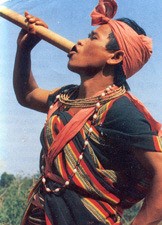Mnong, Central in Cambodia

Photo Source:
Copyrighted © 2026
Asia Harvest All rights reserved. Used with permission |
Send Joshua Project a map of this people group.
|
| People Name: | Mnong, Central |
| Country: | Cambodia |
| 10/40 Window: | Yes |
| Population: | 50,000 |
| World Population: | 90,000 |
| Primary Language: | Mnong, Central |
| Primary Religion: | Ethnic Religions |
| Christian Adherents: | 20.00 % |
| Evangelicals: | 17.00 % |
| Scripture: | Complete Bible |
| Ministry Resources: | Yes |
| Jesus Film: | Yes |
| Audio Recordings: | Yes |
| People Cluster: | Mon-Khmer |
| Affinity Bloc: | Southeast Asian Peoples |
| Progress Level: |
|
Introduction / History
Located in the remote mountainous northeast region of Cambodia, bordering Vietnam, Mondulkiri is the country's largest province and is home to the second largest ethnic minority population, the Bunong (or Phnong). Renowned as elephant tamers, they comprise about 30,000 of the province's estimated 43,000 residents. The Bunong language is the main language spoken in their homes and villages.
What Are Their Lives Like?
The Bunong culture and way of life is intimately associated with the forest area in which they live. Access to land and the forests is essential to their survival. The Bunong practice labor-intensive swidden ('slash and burn') agriculture, following a 15-20 year cycle, using one site for up to five years before moving to a new location.
What Are Their Beliefs?
The Bunong practice animism; the stability of their lives depends on the satisfactory appeasement of various types of spirits. Animal sacrifice plays a vital role in the appeasement process. Weddings, funerals, periods of illness and seasonal celebrations are some of the more significant events requiring sacrifices. In the mid 50s, having heard of minorities in Vietnam turning to Jesus, the Bunong in Cambodia asked the only operating mission agency to send missionaries. This request could not be fulfilled then, nor a second one in the mid-60s. Ten years later, the province was part of the "Ho Chi Minh trail" and the target of US bombing. Many Bunong fled to Vietnam, where they finally heard the Gospel. In 1986, about 150 Bunong believers came back to Cambodia. Today, they are 1000 strong. The first Western missionaries came in 2000.
What Are Their Needs?
Food and land protection: The Bunong experience a period of 3-5 months where the food grown in their fields runs out, so they must forage in the forest, hunt, fish or gather resin to sell. Major tracts of land have been logged, sold or otherwise removed from the traditional ownership of the Bunong community, leading to a decrease in access to life-sustaining resources.
Literacy and education: The majority of Bunong do not have sufficient math skills to fairly buy or sell produce at the market, and few can properly count money or use a scale. They are frequently cheated by local traders. Their ability to interact with the broader society is limited, preventing adoption of innovations and ideas from the outside. Also, as outside influences encroach with alarming speed and impact, the Bunong are ill-equipped to confront the onslaught of changes. Lack of Khmer language skills also render them at even greater risk for exploitation. Health care and education: Many serious diseases have a much higher rate of prevalence in Mondulkiri than in other provinces. Also, the Bunong do not possess basic information which could allow them to treat or prevent simple diseases. Salvation and Scriptures: Only Christ can deliver the Bunong out of their poverty - physically and spiritually. They need God's Spirit to fully transform their lives. The church struggles due to lack of Scriptures in the Bunong language, and also desperately needs strong teaching.